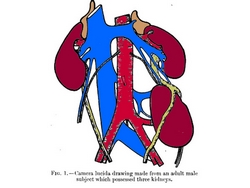"The only constant in anatomy is variation"
This dictum is incredibly powerful and true. Even the so-called "anatomical constants" are subject to it.
One common misconception is that "we are all the same". This could not be further from the truth. Every body is different from every else's body. Anatomical variations range from the minimal to the incredible. One of the most interesting anatomical variations is the one called "situs inversus". In this case the individual is a mirror image of a human. The apex of the heart points to the right side of the body; the duodenum circles to the right, the liver "hangs" from the left side of the respiratory diaphragm, etc. This particular anatomical variation presents in different degrees and can sometimes coexist with some cardiovascular congenital abnormalities.
Of course there are minor anatomical variations that have no effect on daily life at all and are only discovered by accident, or upon autopsy or dissection. One of the most complete resources on this topic is the Illustrated Encyclopedia of Human Anatomic Variations. An excerpt from this site states: "It is clear that textbook writers and teachers over the centuries, even until today, fail to understand or to transmit to their students the crucial concept that anatomical and physiological diversity and variation is a canon of living organisms. This failure leads to the belief that textbooks are conveying immutable facts with only few anomalous exceptions".
Shown here is an extremely rare case of a third kidney. Dixon (1911) describes in his research paper that as of that date, only 10 cases were known, of these only eight were recorded, with 87% of them found on the left side of the body. Click on the image for a larger depiction.
Source and primary image: "Supernumerary kidney: The occurrence of three kidneys in an adult male subject" Dixon, A.F. J. Anat. Physiol. 45:117-121, 1911.
THIS POST IS CONTINUED, CLICK HERE




